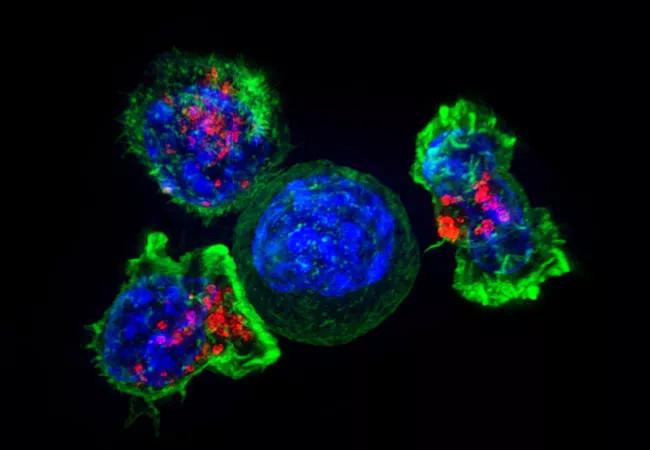Study suggests new approach is safer than standard treatment and may help prevent graft-versus-host disease

Graft-versus-host disease (GVHD) is a significant cause of morbidity and mortality in patients who undergo allogeneic hematopoietic cell transplantation (AHCT). Combination therapy with tacrolimus (Tac) and methotrexate (MTX) is standard care for the prevention of GVHD; however, the drug regimen is associated with several toxicities that prevent many patients from completing the full course of treatment.
Advertisement
Cleveland Clinic is a non-profit academic medical center. Advertising on our site helps support our mission. We do not endorse non-Cleveland Clinic products or services. Policy
According to new findings by Cleveland Clinic researchers, a regimen (known as “mini-MTX”) may be an acceptable alternative to standard full-MTX therapy. Data from a novel head-to-head comparison of the two regimens was presented at the 2021 American Society of Hematology annual meeting in December. Study subjects underwent AHCT from either a matched related or unrelated donor.
“Mini-MTX was associated with less mucositis and organ toxicity and trended toward a lower risk of mortality,” explains Betty K. Hamilton, MD, first author of the study and Interim Director of Cleveland Clinic’s Blood and Marrow Transplant Program. “However, we found no difference in the incidence of acute or chronic GVHD in patients treated with the two protocols.”
The full-MTX regimen used in the study consisted of 15 mg/m2 on day +1 and 10 mg/m2 on days +3, +6, and +11 with tacrolimus, whereas the mini-MTX regimen consisted of 5 mg/m2 on days +1, +3, and +6 plus mycophenolate mofetil 1000 mg twice daily and tacrolimus. The study evaluated 96 patients who received myeloablative AHCT using 8/8 HLA-matched related or unrelated donors.
“Smaller studies have found mini-MTX to be a safe prophylaxis for GVHD, but it has never been studied head-to-head with full-MTX in a prospective trial,” explains Dr. Hamilton. “We set out to fill that gap and determine whether there were any differences between the two treatments.”
Baseline characteristics of the patients in the full- and mini-MTX groups were similar. The median age in the former group was 47 years versus 45 years in the latter group. Diagnoses included acute myeloid leukemia, acute lymphocytic leukemia, myelodysplastic syndromes, chronic myeloid leukemia, myeloproliferative neoplasms and non-Hodgkin’s lymphoma. Both bone marrow and peripheral stem cell grafts were allowed.
Advertisement
The primary end points were the incidence of acute GVHD, mucositis and hematopoietic engraftment. The incidence of chronic GVHD, organ toxicity, infection, relapse, non-relapse mortality (NRM) and overall survival (OS) were the secondary end points.
All subjects in the mini-MTX group completed three planned doses; 71% in the full-MTX group received all four doses, 26% received three doses, and one patient received only two doses.
By day 100, no significant difference in the cumulative incidence of grade 2 to 4 acute GVHD was noted between the two groups (28% mini-MTX vs 27% full-MTX, P=0.41). However, a higher incidence of grade 3 to 4 acute GVHD was noted in the mini-MTX cohort (13% vs 4%, P=0.07).
The incidence of severe World Health Organization grade 3 to 4 mucositis was lower in patients who received the mini-MTX regimen (57% vs 82%, P=0.010), and the duration of this treatment-related side effect was briefer in this group (median 15 vs 17 days, P<0.001). The mini-MTX cohort also had faster engraftment of both neutrophils (median 15 days vs 17 days, P<0.001) and platelets (median 23 days vs 27 days, P=0.023) and a shorter length of hospital stay (median 27 days vs 31 days, P<0.001).
One year after undergoing AHCT, the groups showed no significant differences in the grade of chronic GVHD (36% vs 25%, P=0.09) or moderate-to-severe GVHD (23% vs 20%, P=0.14). The incidence of bacterial, viral and fungal infections was also similar (P=0.18, P=0.52, and P=0.74, respectively).
Advertisement
Significantly fewer patients who received mini-MTX experienced nephrotoxicity (creatinine ≥3 times the upper limit of normal: 2% vs 26%, P<0.001). In the first 6 months after receiving AHCT, this group also had less respiratory failure (6% vs 22%, P=0.026).
Investigators noted no difference between the two arms in the rate of relapse at 2 years (22% vs 21%, P=0.89), but mini-MTX therapy was associated with a lower rate of NRM (11% vs 25% at 2 years) and a higher rate of OS (70% vs 52% at 2 years, P=0.06).
Dr. Hamilton believes these findings underscore the promise of mini-MTX.
“Full-MTX has remained the gold standard for decades because no other GVHD approach was proven to be superior, but the inability of many patients to tolerate the treatment makes it less than ideal,” she explains. “The take-home message from our trial is that not only is mini-MTX safe and less toxic alternative, it also produces similar outcomes in patients undergoing AHCT.”
Advertisement
Advertisement

Study shows high rate of hematologic responses, low rate of disease progression

Bispecific antibody bridging therapy deepens durability of BCMA CAR T-cell therapy without overlapping toxicities in patients with relapsed/refractory multiple myeloma

Phase 2 study brings pivotal advances in treatment efficacy and safety for the most challenging-to-treat population

Patient with quadruple refractory multiple myeloma achieves complete response with cell therapy

Distinct baseline immune profiles can predict response and resistance to different types of CAR-T cells.

National Blood Clot Alliance collaborates with faith-based organizations on first-of-its-kind church bus tour

AI-driven tools can streamline enrollment and improve efficiency across clinical trials.

Patient achieves complete remission from aggressive marginal zone lymphoma with liso-cel